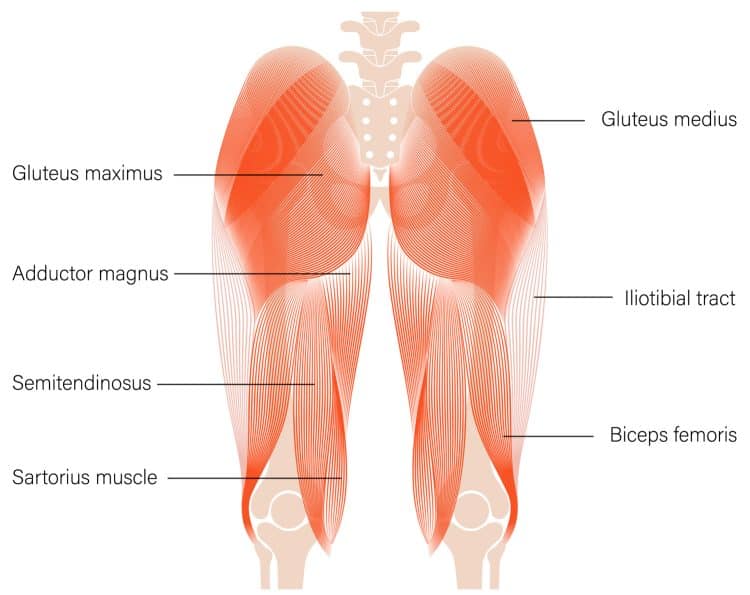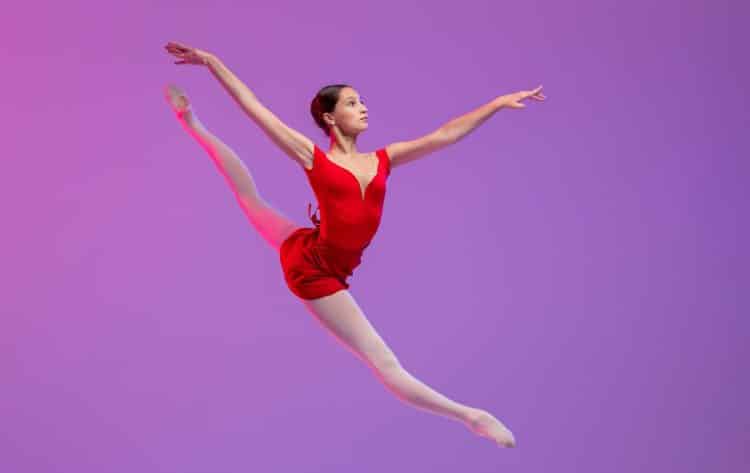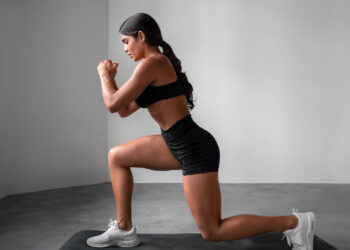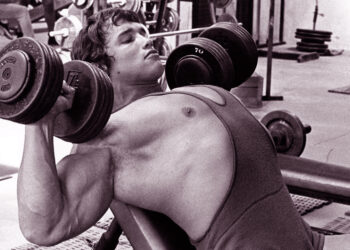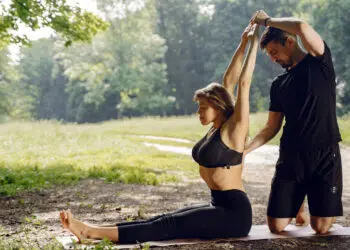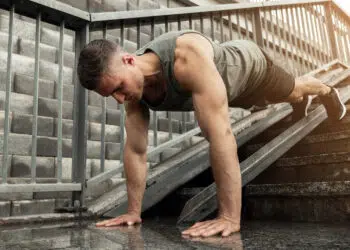Activities like running and lifting weights are good for your health, appearance, and body composition. However, combined with prolonged sitting and too little stretching, they can leave you with sore, tight muscles and immobile, painful joints.
While stretching and mobility training are not as exhilarating or fun as lifting and running, they’re no less important, especially if you want to keep exercising long past middle age.
In this article, we reveal the 12 best exercises for unlocking tight hips and improving your mobility and flexibility.
Hip Anatomy
While you don’t need a degree in anatomy and physiology to stretch and mobilize your hips, understanding a little about how your hips work may help you identify what’s tight and then choose the best exercises for your needs.
Structurally speaking, the hip is similar to your shoulder. Both are ball and socket joints. Ball and socket joints are very mobile but can also be unstable. Because the hip is a weight-bearing joint, it is surrounded by lots of powerful muscles.
While these muscles are great at producing force, they also have a tendency to become short and tight. This problem is often made worse by lots of sitting and doing activities with small but repetitive movements, such as walking, running, and cycling.
Level Up Your Fitness: Join our 💪 strong community in Fitness Volt Newsletter. Get daily inspiration, expert-backed workouts, nutrition tips, the latest in strength sports, and the support you need to reach your goals. Subscribe for free!
The main movements and muscles of the hip joint are:
- Flexion – iliopsoas, rectus femoris, sartorius, pectineus.
- Extension – gluteus maximus; semimembranosus, semitendinosus, and biceps femoris (the hamstrings).
- Abduction – gluteus medius, gluteus minimus, piriformis and tensor fascia latae.
- Adduction – adductors longus, brevis and magnus, pectineus and gracilis.
- Lateral rotation – biceps femoris, gluteus maximus, piriformis, assisted by the obturators, gemilli, and quadratus femoris.
- Medial rotation – anterior fibers of gluteus medius and minimus, tensor fascia latae.
Do You Have Tight Hips?
Because the hip is such a mobile joint, you’ll need to stretch and mobilize it in all directions. For example, it’s not enough just to stretch your hamstrings and hip flexors. You also need to pay attention to your medial and lateral rotators, and abductors and adductors.
How do you know if your hips are tight? By performing some rudimentary mobility and flexibility assessments!
Perform the following to determine which hip muscles you need to stretch.
1. Hip flexion test
The hip flexion test assesses hamstring and gluteus maximus tightness. Problems with these muscles can affect your lower back and posture and could reduce squat depth.
How to do it:
- Lie on your back with your legs together. Rest your arms on the floor by your sides.
- Lift one leg as high as possible without bending your knee or lifting your butt.
- Note the angle of your leg.
- Repeat on the other side.
Ideally, you should be able to raise your leg to 90 degrees, and anything less than 60 degrees needs work! You can also do this exercise passively, i.e., having a training partner or coach lift your leg for you. Compare your left leg to your tight leg, as flexibility discrepancies can also be problematic.
2. Hip abduction test
This test assesses for hip adductor tightness. Tight adductors can cause your knees to drop inward when you run or do squats and also increases your risk of “groin strains,” which are a common problem for runners and soccer players.
How to do it:
- Lie on your back with your legs together. Rest your arms on the floor, away from your sides.
- Keeping your legs on the floor, slide one out and away as far as you can from the midline of your body. Make sure your pelvis remains stationary.
- Note the angle of your leg.
- Repeat on the other side.
You should be able to achieve 45 degrees of leg abduction. Anything less than this means you have tight adductor muscles.
3. Thomas test
Named after Welsh orthopedic surgeon Hugh Owen Thomas, the Thomas test assesses hip flexor tightness. Prolonged sitting means that many people have tight hip flexors.
How to do it:
- Sit on the end of a table or bench. Bend one leg and pull your knee toward your chest. Let your other leg relax and hang down toward the floor.
- Lower your back to the table/bench and note the position and angle of your extended leg.
- Sit up, switch sides, and repeat.
Ideally, the knee of the extended leg should be both bent and below the level of your hips. A straight leg suggests that the rectus femoris is tight, while a raised knee indicates a tight iliopsoas. It’s very common to have both of these symptoms.
4. Seated 90/90 hip rotation test
Tight hip rotators are very common. Why? Because hip rotation is a relatively rare movement in everyday life.
Tight hip rotators can cause issues with your walking and running gait, leading to knee, hip, and even lower back pain. Tight hip rotators can also make it harder to squat and lunge with good technique. This test will reveal just how tight your hip rotators are.
How to do it:
- Sit on the floor with your legs bent to 90 degrees and your feet flat. Your torso should be upright. Lift your arms forward and hold them parallel to the floor.
- Rotate your legs in the same direction and attempt to lower your knees to the floor without twisting your upper body or lifting your butt off the floor.
- Perform this movement to both sides.
To pass this test, you should be able to get both knees to the floor while having a 90-degree bend in both legs. However, if your butt lifts or you have to use your hands for support, you’ve failed the test and need to work on hip rotation mobility.
The 12 Best Stretches for Flexible, More Mobile Hips
Mobility and flexibility are two different things, and you need both for healthy hips. Mobility is your ability to actively move your joints through a large range of motion. In contrast, flexibility is the ability to passively stretch your muscles.
Mobility and flexibility are interrelated, and exercises for one component often improve the other. However, in some cases, mobility and flexibility are best performed separately. For example, mobility exercises make for great warm-ups. In contrast, stretches are often better done as part of your cool-down.
Here are 12 of the best hip mobility and flexibility exercises. And don’t worry; we’ll tell you if you are working on passive flexibility or active mobility so you can choose the best exercises for your needs.
1. Butterfly stretch
This a simple passive stretch for your adductors or inner thighs. However, because it’s done with bent legs, it tends to affect the muscles closest to your groin the most. Adductor muscles that attach lower on your femurs are less affected.
Steps:
- Sit on the floor with your legs bent and the soles of your feet pressed together. Clasp your feet and pull them in close to your groin. Sit up tall and straight. Relax your shoulders and arms.
- Either using your elbows or your hip abductors, push your knees out and down toward the floor.
- Hold for 30-60 seconds and then release.
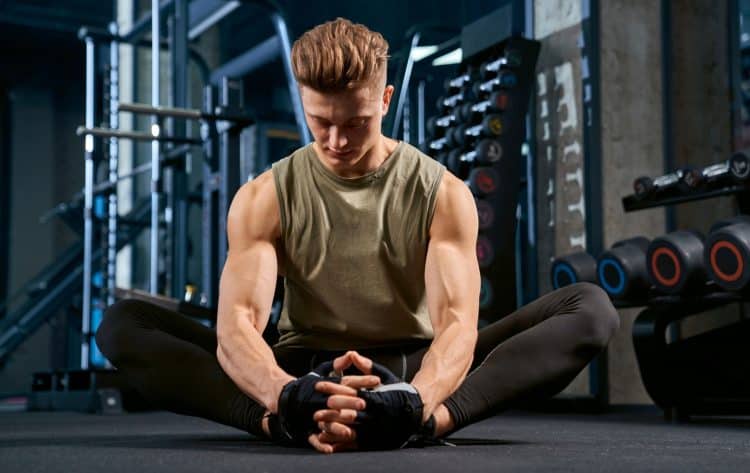
Tips:
- Does your lower back round when you’re doing this exercise? Fix this problem by sitting on a cushion or yoga blocks to raise your hips and take the stress off your lower back.
- You can also do this exercise lying flat on your back, which may be more comfortable for some people.
- Get a deeper stretch by resting weight plates on your knees and holding for 3-5 minutes.
2. Runner’s lunge
The runner’s lunge isn’t just for runners. Instead, it’s an excellent stretch for your hip flexors. These muscles are often tight because of prolonged sitting. Do this stretch hourly to break up long stints working at your desk or driving.
Steps:
- Kneel on the floor and then step forward, so you’re resting on one knee. Place your hands on your front leg for support.
- With your torso upright, push your hips forward to stretch the hip flexor on your rearmost leg. Move your rear leg back if you need a deeper stretch, taking care not to hyperextend your hip or lumbar spine.
- Hold for 30-60 seconds, relax, and swap legs.
Tips:
- Increase the stretch by placing your front foot on a four to eight-inch platform, e.g., a couple of bumper plates.
- Stretch your rectus femoris more by bending your rear leg, reaching back, and gently pulling your foot toward your butt, like this:
3. Figure four stretch
The figure four exercise passively stretches your hip rotators and glutes. It’s also a great way to ease lower back tension. However, it is pretty challenging, especially if you’ve got tight hips. Ease into it and relax, and never force the stretch, as that’s a good way to get injured.
How to do it:
- Lie on your back with your legs bent and feet flat on the floor. Cross your left ankle over your right knee.
- Reach down and grip your right leg. Gently pull it toward you to feel a stretch in your left outer hip. Keep your head and shoulders on the floor throughout.
- Hold for 30-60 seconds, relax, and switch sides.
Tips:
- Pull your leg closer in to get a deeper stretch.
- Loop a towel around the back of your leg if you are unable to reach it comfortably. Hold the ends of the towel instead of your leg.
- You can also do this exercise seated instead of standing, like this:
4. High lunge
The high lunge is a part passive stretching and part strengthening exercise. Because it’s such an active exercise, it’s excellent for warm-ups and any other time that you want to stretch your hips without putting the muscles to sleep. This exercise is also good for building better end-range strength balance.
Steps:
- Take a large step forward as though you were going to do a lunge. Your feet should be roughly shoulder-width apart.
- Keeping your rear leg straight, bend your front knee and push your hips forward until you feel a stretch in your hip flexors.
- Make sure your rear knee is pointing forward and not turned inward or outward.
- Hold for 30-60 seconds, and then switch sides.
Tips:
- Do this exercise next to a wall for balance and support if necessary.
- Combine this exercise with the runner’s lunge (#2) to stretch your hip with a bent and a straight leg, i.e., start with your rear knee resting on the floor and then straighten it.
- Make this stretch more challenging by raising your arms above your head.
5. Frog stretch
Do you have good flexibility but want to improve it even more? If so, the frog stretch is for you. This demanding exercise will open your hips and stretch many major hip muscles. You’ll be using your body weight to pry your hips open, which is why this is such an advanced exercise. So, ease into it – trying to rush this one could result in injury.
Level Up Your Fitness: Join our 💪 strong community in Fitness Volt Newsletter. Get daily inspiration, expert-backed workouts, nutrition tips, the latest in strength sports, and the support you need to reach your goals. Subscribe for free!
Steps:
- Kneel on all fours so that your hands are under your shoulders and your knees are beneath your hips.
- Shift your weight forward onto your hands.
- Spread your knees as wide as possible while keeping them in line with your hips.
- Your legs should be bent to roughly 90 degrees.
- Lower your weight onto your forearms. Your elbows should be below your shoulders.
- While taking a deep breath, push your hips back as far as possible.
- Hold in the most stretched position or move in and out of the stretch for repetitions.
Tips:
- Only do this stretch after a warm-up involving less intense hip stretches.
- Keep your head and lumbar spine neutral to avoid unnecessary tension on your neck.
- Place a folded exercise under your knees for comfort.
6. Supine assisted hamstring stretch
The great thing about the supine assisted hamstring stretch is how easy and relaxing it is to perform. Using a yoga strap or towel means you can use your arms to gently and passively stretch your hamstrings. This exercise is suitable for all levels – from ultra-tight beginners to very flexible advanced.
Steps:
- Lie on your back on an exercise mat. Hold a long towel, yoga strap, skipping rope, or similar in your hands.
- Raise one leg and loop the middle of your strap over your raised foot.
- Keeping your knee straight but not locked, pull your leg as close to vertical as possible without straining.
- Hold for 30-60 seconds.
- Release the stretch, lower your leg, switch sides, and repeat on the other side.
Tips:
- Do this exercise with your opposite leg bent or straight to see which option you prefer.
- Pull your toes toward your shins to get a secondary calf stretch as you work your hamstrings.
- Pull your leg out to the side to increase the stretch on your adductor or inner hip muscles.
- Ease off if you feel your leg starting to shake. This indicates that you are trying to stretch too far or too fast. Gradually increase the depth of the stretch as you feel your muscles relax.
7. Asian squat
The Asian squat is something that most kids do naturally. But, as they age and start to use chairs more, their hips tighten up, and they lose the ability to sit, rest, and play in this natural position. You can win back your hip mobility by reintroducing the Asian squat into your mobility routine. However, don’t be surprised if, initially, you can’t get very low or hold it for long.
Steps:
- Stand with your feet about shoulder-width apart, toes turned slightly out. Brace your core and pull your shoulders back and down.
- Bend your legs and squat down until your hamstrings are resting on your calves. Push your knees forward and outward as you descend.
- Use your body weight to press your knees forward and your heels downward. Sit and relax in this position for as long as possible. Your torso should be fairly upright with minimal rounding of your lower back. Think about lowering your butt down as close to the floor as possible.
- Slowly stand back up. You may feel a little dizzy, but this should soon pass and cease to be a problem as you get used to the exercise.
Tips:
- Squat while holding a pole or railing for balance to develop your confidence and basic mobility.
- Place a yoga block or low step behind you and squat down until your but is resting on it. Reduce the height of the block until you can do the Asian squat unaided.
- Experiment with different foot widths until you find the most comfortable position.
- Try to Asian squat for about 10-15 minutes per day, broken into 1 to 3-minute sets.
8. Quadruped hip circles
The hip joint is capable of circumduction, which is a cone-shaped or circular movement only possible in ball and socket joints. This exercise takes your hips through this movement providing a great way to warm up and lubricate your hip joint. This is undeniably a hip mobility exercise.
Steps:
- Kneel on all fours so that your hands are under your shoulders and your knees are beneath your hips.
- Keeping your knee bent, make forward or backward circles with one leg.
- Do 10-15 reps one way and then reverse direction.
- Do the same number of reps on each leg.
Tips:
- Place a folded may beneath your knees for comfort.
- Brace your core and engage your glutes to stabilize your lumbar spine.
- Increase the size of your movements as you feel your hip begin to warm up.
9. Seated 90/90 hip rotations
This dynamic hip mobilizer is a progression from the seated 90/90 hip rotation test. Use it to warm up your hips and improve medial and lateral hip rotation. A few weeks of this exercise, and you’ll ACE the hip rotation test!
Steps:
- Sit on the floor with your legs bent and feet flat. Adopt a tall posture and extend your arms in front of you.
- Keeping your butt on the floor, slowly roll both knees to one side, trying to get them as close to the floor as possible. Your legs should both be bent to 90 degrees.
- Roll your hips to the other side and repeat.
- Continue until your hips feel warm and loose.
Tips:
- Don’t worry if you can’t get your knees to the floor. Your mobility will improve with practice and training.
- Place your hands on the floor behind you if necessary. Try to rely on them less over time.
- Increase your range of motion as your hips warm up and get loose.
10. Cross-body leg swings
This dynamic mobility exercise is popular with runners and athletes. It mobilizes the hips while stretching the abductors and adductors. It also activates the glutes and improves hip and core stability. A set or two of this exercise before a run or squat workout will do wonders for your performance.
Steps:
- Stand facing a wall, fence, squat rack, or anything else you can use for balance. Place your hands against it at around shoulder height.
- Hinging slightly from the hips, swing one leg across your body so your foot follows a broad arc.
- Continue for the desired number of reps, and then swap legs.
Tips:
- Keep your supporting leg slightly bent for stability and balance.
- Turn your hips as you swing your legs to mobilize your lumbar spine.
- You can also rise up onto your toes as you swing your legs to mobilize your ankles and hips at the same time.
11. Hip CARs
Hip CARs (Controlled Articular Rotations) take your hip joint through its full range of motion. It’s a very effective exercise that opens the joint, increases range of motion, and improves hip function. It’s also good for the health and integrity of the joint. CARs are ideal for warm-ups.
Steps:
- Stand side-on to a railing, wall, or squat rack and hold it for balance. Brace your core and drive your inside leg down hard, keeping your knee locked.
- Raise your outside knee forward and up as high as possible without leaning back.
- Open your hip and turn it out to the side while keeping your pelvis still.
- Rotate your hip inward and turn the sole of your foot up to the wall behind you. Again, ensure your pelvis remains stationary so that the movement comes from your hips.
- Sweep your leg back and into hip extension.
- Lower the knee directly underneath your hip, maintaining a 90-degree angle at the knee.
- Reverse motion and repeat.
Tips:
- Imagine you are lifting your knee and foot over a fence. This will help ensure you perform the movement correctly.
- Keep your knee bent to 90 degrees throughout.
- Do 2 to 3 sets of 3-5 reps in each direction per side.
12. Hurdle walks
Hurdle walks are another hip dynamic hip mobilizer from the wonderful world of sports. A lot of gyms have agility hurdles, and this exercise is perfect for warming up your hips before squats or sprints. Plus, because you can adjust the height of the hurdles, you can make this exercise more challenging as your hip mobility improves.
Steps:
- Set up a run of 6-10 hurdles. They should be about knee height.
- Starting at the first hurdle, walk forward and step over each one in turn.
- Pull your leading knee up and into your chest as you bring your trailing leg out and around to the side.
- Either alternate legs or do one run leading with your left leg and a run leading with your right leg.
Tips:
- Increase the height of the hurdles as your hip mobility improves.
- Bring the hurdles closer together to make this exercise more challenging.
- Stand to the side of the hurdles and only lift your nearest leg over if you want to work one hip at a time.
Hips Stretches FAQs
Do you have questions about hip flexibility and mobility? We’ve got the answers!
1. How often should I perform hip flexibility and mobility exercises?
While you should always do hip mobility exercises as part of your warm-up and hip stretches in your cool-down, you’ll probably benefit from doing some of these exercises on a daily basis, too. That’s especially true if, like most people, you spend a lot of time sitting down.
So, do hip flexibility and mobility exercises every day to ward off the damaging effects of prolonged sitting. Make them part of your morning routine, or just do a few throughout the day when you’ve got a few minutes free. Better yet, try stretching and mobilizing every hour or so to unlock your hips after sitting for a long time.
2. I can feel my hips popping and grinding. Is this normal?
Joint “noise” is called crepitus and is usually nothing to worry about. While the ends of your bones are covered in protective hyaline cartilage and lubricated with synovial fluid, that doesn’t mean there won’t be some friction when you move.
You will probably find these symptoms become less noticeable after working on your hip mobility for a few weeks.
However, if that popping and grinding are accompanied by severe stiffness or hip pain or your joints lock, you should seek medical advice. Symptoms like this suggest that there may be something wrong with the joint.
3. How do gymnasts, martial artists, dancers, etc., develop such incredible hip flexibility and mobility?
Like most aspects of fitness, genetics play a big part in how flexible you can become. That said, stretching at a young age, when muscles are more responsive and adaptable, will help, too.
Women also tend to be naturally more flexible and mobile than men. This is because they have a larger amount of the hormone relaxin, which is crucial for childbirth and increases tissue elasticity.
However, gymnasts, martial artists, etc., also spend entire training sessions working on their flexibility and stretch every day. Because stretching is a low-intensity activity, you can do it long and often.
If you are serious about taking your flexibility to a new, more impressive level, you must prioritize it in training.
4. Is it okay to stretch a cold muscle?
Warm muscles stretch more easily than cold muscles. As such, it’s usually best to do a few minutes of easy cardio before you begin stretching to warm up your muscles. That said, if that is not practical, you can simply start off with an easy stretch and then go deeper as you feel your muscles warm up and relax.
However, stretching too far too fast can cause serious injury, so make sure you progress slowly and avoid doing too much too soon.
5. What is ballistic stretching?
Ballistic stretching combines flexibility and mobility training. It’s a very aggressive form of stretching that is only really suitable for advanced exercisers and athletes. However, for most people, the risks far outweigh the benefits.
You can read more about ballistic stretching in this in-depth guide.
6. I used to be very flexible, but now I’m stiff as a board. What happened?
Flexibility and mobility tend to decline with age. Your body operates on a system of “use it or lose it.” Kids are often very active, and movement helps develop flexibility and mobility.
However, as we age, most adults usually adopt a more sedentary lifestyle, and even if they do exercise, they also spend much of their time sitting. This lack of activity leads to a decrease in flexibility and mobility. In simple terms, you aren’t doing anything that demands supple muscles or mobile joints, so your body tightens up.
The good news is that regular training can help you win back much of your lost mobility and flexibility. However, you may never be as mobile or flexible as you were when you were a kid.
Closing Thoughts
Tight hips are a plague of modern living. Too much sitting and too many repetitive activities mean that a lot of people experience the discomfort and poor athletic performance caused by tight, immobile hips.
The good news is that you can regain lost hip mobility and flexibility. All you need to do is commit to stretching and mobilizing your hips. However, the occasional stretch won’t do it. Rather, you must commit to working on your hip mobility and flexibility most days of the week.
Use the exercises in this article to restore lost hip mobility and flexibility. It’s going to take some time, but your efforts will be rewarded!

